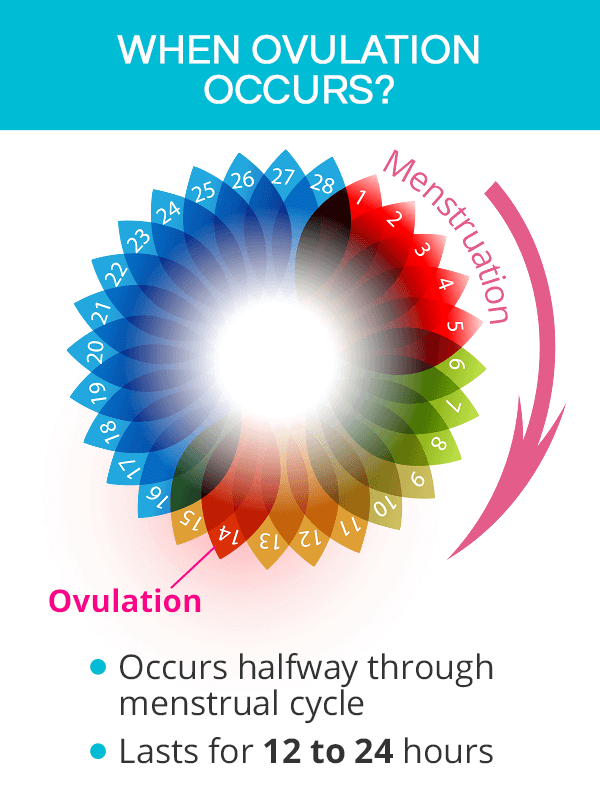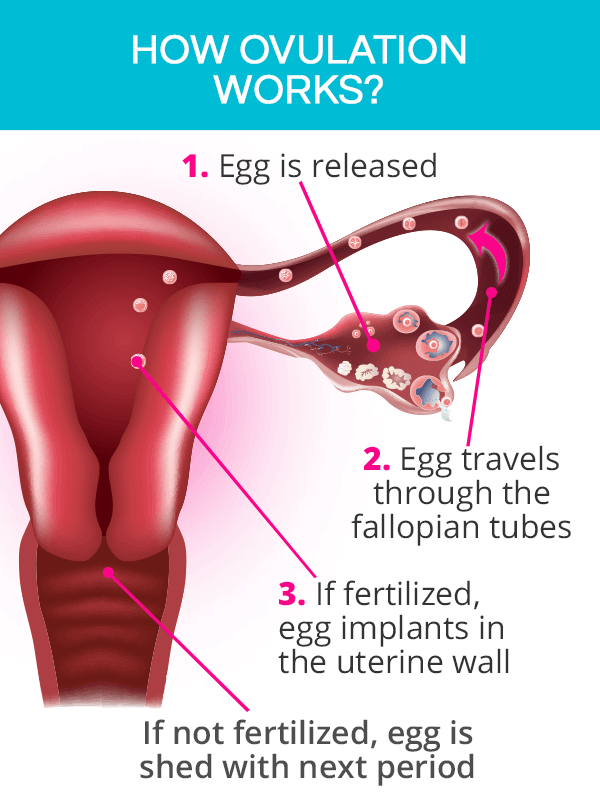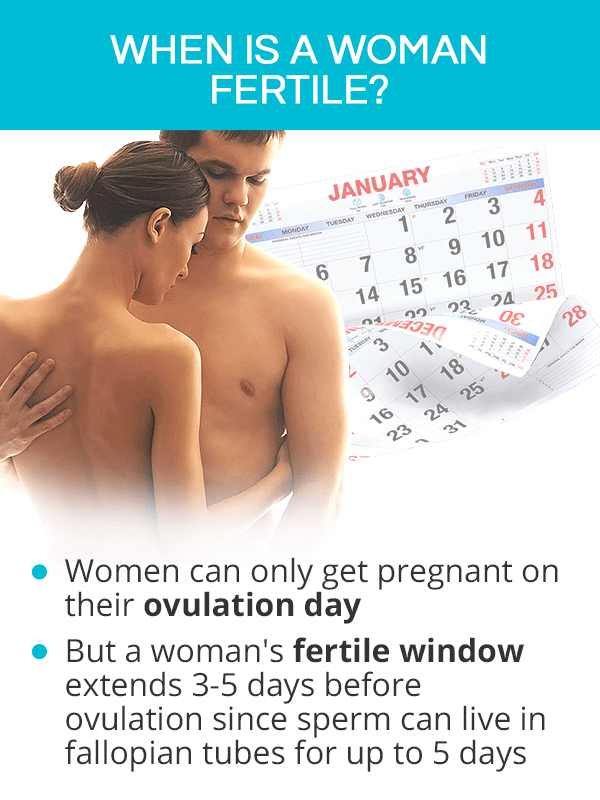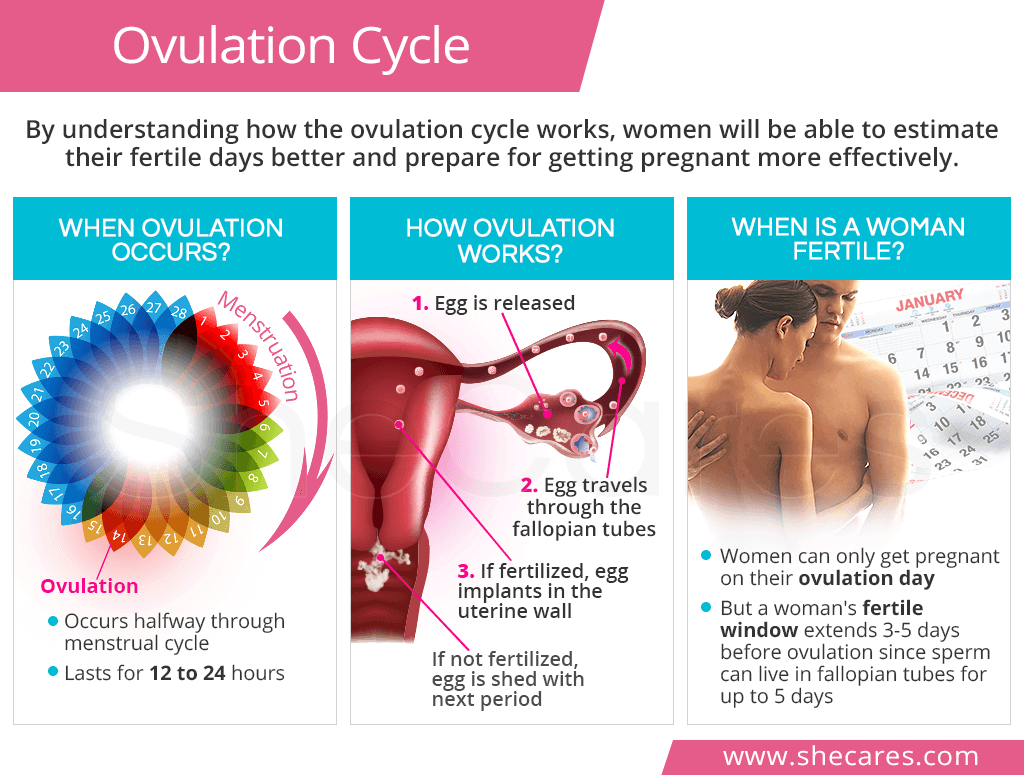When Does Ovulation Occur?

Learning how to estimate the ovulation date is one of the most important parts of pregnancy preparations.
Ovulate Date
Ovulation occurs roughly in the middle of a woman's menstrual cycle, lasting for 12 to a maximum of 24 hours. Ovulation starts with the release of an egg by the ovary and ends with its passage to the uterus. If not fertilized, it is broken down.
The exact date of one's average ovulation day mainly depends on the length of a woman's cycle. Generally, it comes about 14 days before a period. So, considering a 28-day menstrual cycle as average, ovulation is likely occur on Day 14, right in between the two menstrual phases:
Follicular phase starts on the first day of menses and lasts until ovulation (Day 1 to 13)
Ovulation lasts for 12 to 24 hours (Day 14)
Luteal phase starts from ovulation until subsequent bleeding (Day 15 to 28)
However, it is perfectly normal for women to have shorter or longer menstrual cycles, for example, those lasting between 21 and 35 days. Longer cycles or irregular periods might be a signal of ovulation problems and should be evaluated by a doctor.
Estimating Ovulation Date
Because conception can only occur during ovulation, knowing how to estimate the ovulation day is necessary for getting pregnant.
There are a number of accurate ways to predict the time when a woman is ovulating, which might include:
Ovulation signs and symptoms, such as egg white-consistency cervical mucus, mild pelvic pain, or increased libido, might help a woman know when her ovulation starts.
Ovulation tests include self-assessment, such as measuring basal body temperature or checking cervical mucus, or at-home test kits, which detect hormonal changes preceding ovulation.
Ovulation predictors are helpful tools enabling women to monitor the patterns of their menstrual cycles to be able to estimate ovulation time more accurately. They include ovulation calendars or calculators and ovulation trackers or monitors.
How Does Ovulation Work?

A series of hormonal changes and reproductive events taking place throughout the menstrual cycle allow ovulation to work as it should.
Stages of Ovulation
Ovulation can be explained in three steps:
Release of the egg. In the days following a period, a number of eggs mature in the follicles located in the ovaries. Usually one of those follicles becomes dominant, which means it matures faster, breaks open, and releases the egg. This marks the beginning of ovulation.
Journey of the egg. In the next 12 to 24 hours, the egg travels down the fallopian tubes to the uterus. Along the way, it can be fertilized if the sperm is present in the fallopian tubes.
Arrival at the uterus. If the egg is fertilized, it implants itself in the uterine lining, and the pregnancy progresses. If the egg arrives at the uterus unfertilized, this marks the end of ovulation. The egg and the lining of the uterus start breaking down to be eventually shed through the cervix and the vagina during the next menses about two weeks later.
Ovulation Hormones
Ovulation, as well as all other events before and after ovulation, are controlled by key reproductive hormones:
Estrogen gradually increases in the days leading up to ovulation, stimulating the uterine lining to thicken and eventually trigger the LH surge. After ovulation, estrogen levels decrease if fertilization does not occur, causing the lining to break down. If pregnancy does occur, estrogen levels increase to support it.
Luteinizing hormone (LH) peaks only once during the entire menstrual cycle. This LH surge triggers ovulation by stimulating the release of an egg from the ovary.
Progesterone starts to increase with the onset of ovulation to prepare the uterine lining for the fertilized egg. If fertilization does not happen, progesterone levels decrease, which initiates the dissipation of the lining. In the case of pregnancy, progesterone increases to prevent the lining from shedding.
Follicle-stimulating hormone (FSH) stimulates the pituitary gland to stimulate the ovaries to mature the egg-containing follicles, which happens in the beginning of the menstrual cycle. As they grow, follicles produce estrogen in the days leading up to ovulation.
When is a Woman Fertile?

It is perhaps the most important question a woman preparing for pregnancy can ask: when are you most fertile?
As stated above, the egg is alive for only 12 to 24 hours as a woman ovulates, during which it can be fertilized. However, her fertile period actually extends to several days before ovulation.
Fertility before Ovulation Day
In the days right before ovulation, a woman is not fertile. In other words, fertilization cannot happen because the egg has not been released yet.
However, sperm has a longer life span than the egg. It can live in the reproductive tract for two to five days, depending on several factors, such as the quality of cervical mucus or sperm motility. So, if a woman has sex a few days before she ovulates, the chances of conceiving are high because the sperm is already present in the fallopian tubes once the egg is released.
Those six days (five days before ovulation and the ovulation day itself) are referred to as the fertile window, or fertile period. Particularly the two to three days immediately preceding ovulation are considered high fertility days, or best days to get pregnant.
Fertility on Ovulation Day
On the day of ovulation, fertility is still high, but because ovulation is relatively short, some couples might not be able to time it right with having sex and miss their window. Some sperm might take half an hour to get to the egg, while others might take hours or even days.
It is, therefore, recommended to have sex daily two to three days before ovulation and on the ovulation day to increase the chances of conceiving.
Fertility after Ovulation Day
Once the egg passes through the uterus and starts breaking down, the fertile days are over, and fertilization can no longer happen until the next cycle begins.
Key Takeaways
Ovulation is a 24-hour period in between a menstrual cycle, during which en egg is released from the ovary and makes its way to the uterus. It can be fertilized along on the way. Because the sperm can survive in the fallopian tubes for up to five days, a woman's most fertile days include three to five days preceding ovulation as well as the ovulation day. Since a woman can only get pregnant during ovulation, being able to estimate that fertile window is necessary for successful conception.
Sources
- American Pregnancy Association. (2018). Understanding Ovulation. Retrieved August 22, 2018 from http://americanpregnancy.org/getting-pregnant/understanding-ovulation/
- Cleveland Clinic. (2013). Female Reproductive System. Retrieved August 22, 2018 from https://my.clevelandclinic.org/health/articles/9118-female-reproductive-system
- Mayo Clinic. (2016). Menstrual cycle: what's normal, what's not. Retrieved August 22, 2018 from https://www.mayoclinic.org/healthy-lifestyle/womens-health/in-depth/menstrual-cycle/art-20047186
- Medline Plus. (2018). Pregnancy – identifying fertile days. Retrieved August 22, 2018 from https://medlineplus.gov/ency/article/007015.htm
- Office on Women's Health. (2018). Your menstrual cycle. Retrieved August 22, 2018 from https://www.womenshealth.gov/menstrual-cycle/your-menstrual-cycle
- PubMed. (2018). Ovulation. Retrieved August 22, 2018 from https://www.ncbi.nlm.nih.gov/pubmedhealth/PMHT0022598/
- Your fertility. (2018). Women's guide to getting the timing right. Retrieved August 22, 2018 from https://yourfertility.org.au/for-women/timing-and-conception/


